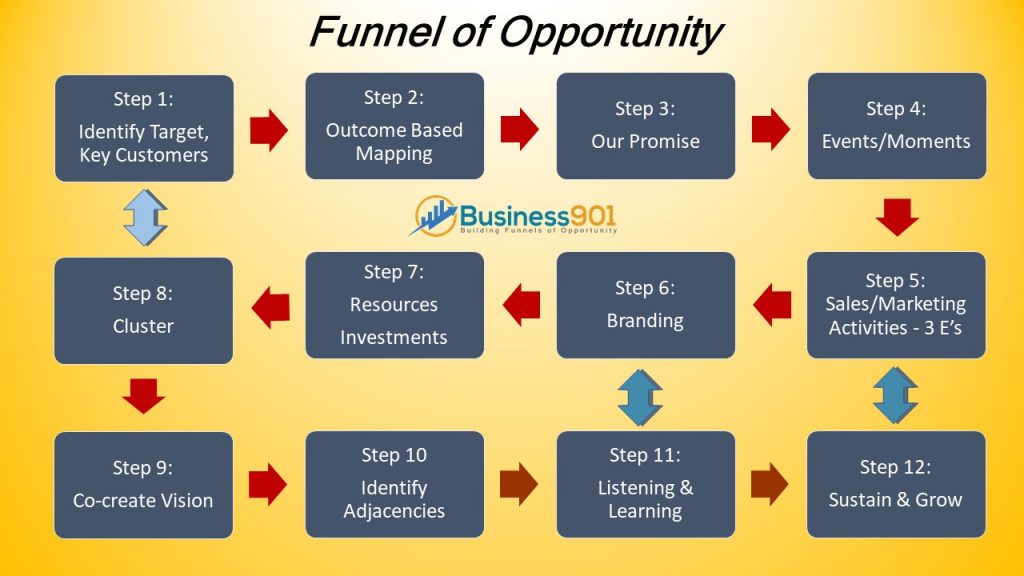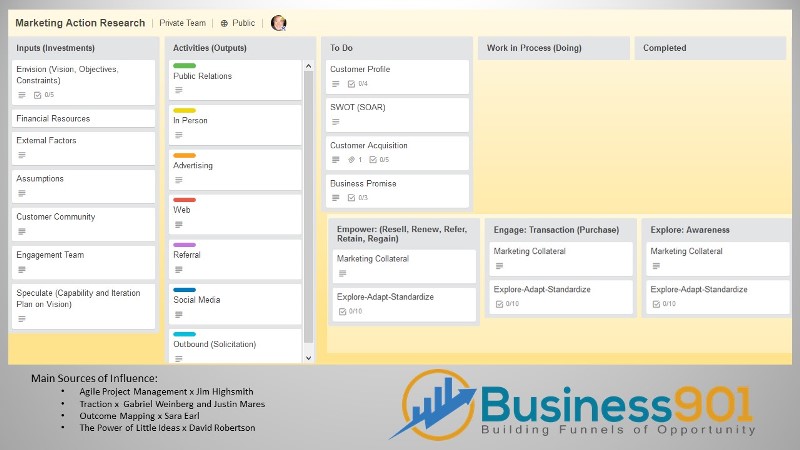A marketing plan is not anything more than a hypothesis. It is the ability to learn from them and build on each conversation is what makes a plan plausible.
A marketing effort first and foremost begins by developing an unbiased analysis of your marketing environment focusing not just on practical information collection, but on analyzing the information in a rigorous manner. The goal is to feel that in completing the initial research you become engaged in the market spaces related to your key customers/prospects. In that sense, it’s more than a process that you apply; it is a muscle that you build and becomes part of the conversation you bring to the world.
The goal of the marketing process is to empower and creatively and intensively research the two or three customer clusters that will determine the success or failure of your sales efforts. You become knowledgeable about what really matters. To me, that’s the foundation of practical and actionable marketing. You then build upon those clusters incrementally and in exploratory methods to form new.
The digital age has changed the way we deliver marketing, the way we execute. Marketing is no longer driven by the creative, it is driven by the process. Learning becomes paramount and is driven by the way you interact and structure your customer engagement. Marketing is no longer just about getting the message out. It is just as important to get the message in. Creating a plan in isolation from customers says that you know everything you need to know starting at the beginning. It indicates that you are smarter than the market. Marketing must evolve through our actions and tactics.
In the past, we looked at marketing to the masses and in the hope that we will find a likely candidate and narrow them down through discovering how much pain they are in relative to our product offering. Our attempt to create effectiveness is to manage and segment the top of the funnel. But why? It is our least known area and by and large the least receptive to our message.

The Funnel of Opportunity is a 12-step process working from the known to the unknown. We iterate looking first at key customers, then similar customers, and again to identify market segments. It is through this practice that we develop the necessary understanding of our customers and the markets we participate in.
We create a useful list of suggested sources of information and questions to consider as we collect, analyze, and synthesize the data related to your markets. Refining our process does not mean narrowing your thinking. It’s the opposite. By pushing ourselves to do research and analysis out of your comfort zone, we will push our thinking in constructive ways. The idea is to continually receive new inputs so that we gain insight from others.
Recognizing where things may be working for you (where you have an edge) and where you may be at a disadvantage (facing a potential pitfall) can make the process more effective and efficient for you, even before we start. That way, you may think about how to counter your weaknesses and capitalize on your strengths. Documenting is where learning takes place; without this step, our marketing begins based on guesswork and speculation.
I believe that marketing must evolve. If it was so simple that I could look at your website and just create a plan, I think you would have already done that. It is not about the tools you use; it is about the conversations you create. It is useful to use the metaphor of conversations when thinking about creating marketing frameworks. Conversations in your marketing space help you identify the proper perspectives as it relates to relevance, credibility, usefulness, and insightfulness within a larger context of what is known and what may be learned.
An audit or assessment is done to determine a current state. In that assessment, I provide an outline of 21 different marketing channels and which ones I recommend trying first. We discuss and form a hypothesis and decide how we can test it. Below are the activities we will consider and prioritize based on our initial work. These channels are the front end of our business spear, heavily shaping the target customer, price point and more.

Sales/Marketing Channels:
- PR: Public Relations (PR) and Unconventional PR
- Referral: Viral Marketing, Affiliate Programs, Existing Platforms (Amazon, Google, etc.)
- Advertising: Social and Display Ads, Search Engine Marketing (SEM – PPC) and Offline Ads
- Social Media: Content Marketing, Email Marketing, Engineering as Marketing, Target Market Blogs and Community Building
- Web: Search Engine Optimization (SEO), Social Media Optimization, and Website
- In-Person: Sales, Trade Shows, Offline Events, and Speaking Engagements
- Business Development: Partnering, Integrations, Wholesale Distribution, Regional and National Representatives, Retail, Service Centers, Trade Centers, and Brokers,
An important note is that many companies in dire situations have gotten there by not adapting to new business models, platforms, service offerings and pricing. In the short term, repackaging of services may be needed and/or cost-cutting. This is also often required entering new markets where entrenched competition is already in place. However, the goal isn’t simple to cut cost but to reposition the business model to increase long-term competitiveness. After that and only after that can the idea of channels be addressed and pricing for that matter. Most people develop pricing before ever figuring what channels they are going to use and determine what the cost of acquiring a customer is.
This may not be a linear exercise. And it does not take as long as you may think. What takes time is to stop thinking of “What I am good at?” to the idea of “What do customers need and want?” It is just as important for sales and marketing to get the message in as it to get the message out.
Marketing is an iterative process that takes shape as knowledge emerges. The premise here is that you learn, you do, you reflect, you learn how to do better, you do it better, you learn from that, do it better still, and so on. You work through a series of continuous improvement cycles that converge towards better situation understanding and improved action. The goal is to refine methods, data, interpretation continuously and to understand deeper the learning developed in the cycles. This is not a passive exercise. It is co-created with the marketplace. It is our way of testing and accelerating product/service entry.
Creating an adaptive plan is simple. Note: I have stayed purposely away from Lean Terminology and used the outline for adaptive planning developed by Jim Highsmith. In Lean, it would be CAP-Do transitioning into SDCA, PDCA, EDCA.
- Create a Current State
- Evaluate what is working and what is not.
- Envision a realistic future state for 90 days from now. (Determine Objectives, Constraints & Assumptions)
- Speculate – (Develop a capability and Iteration plan)
- Determine activities to continue doing, what to stop, improve on and to start new.
- Assign resources, time and money to activities.
- Explore – (Run small iterations seeking to reduce risk and uncertainty)
- Adapt (review results)
- Determine to iterate again (explore) or loop to speculate or close and automate.
 Markets have always been complex and socially constructed. In the future, we will have shift out strategic thinking to focusing on context (definition of market based on who our customers are), value creation and cooperation in the area of use, and non-predictive strategizing and experimentation. Paraphrased from the book: SMASH: Using Market Shaping to Design New Strategies for Innovation, Value Creation, and Growth:
Markets have always been complex and socially constructed. In the future, we will have shift out strategic thinking to focusing on context (definition of market based on who our customers are), value creation and cooperation in the area of use, and non-predictive strategizing and experimentation. Paraphrased from the book: SMASH: Using Market Shaping to Design New Strategies for Innovation, Value Creation, and Growth:
However, markets are not deterministic. They cannot be analyzed, predicted, and processed using cause and effect. This thinking still resides mostly because of a lack of articulated alternative which is inherently difficult in a complex-adaptive world. Markets as a system (Systems Thinking) not a marketing system constantly evolve; partly by random “emergence” and partly by market shaping like an Airbnb or Uber.
The difference in thinking is that they are part of the market, rather than marketing to a market. A space that is not intuitively obvious or structurally predictable. It is a space that strategy once resided. It has been replaced with a perspective that is more aligned with the sales process versus the old marketing process. It is driven by actions and tactics.
“With tactics in the driver’s seat, everything changes: long-term vs. short-term becomes meaningless; prediction is still possible as an activity, but probably futile in its results; action beats analyzing-, correctable replaces dependable. The one thing that we know is that it’s in the learning rather than the deciding.” The Death of Strategy – Forbes.com
The typical marketing system is brittle, not malleable.Doing marketing even focused limited marketing is messy. There’s a wealth of information and details to keep track of. I suggest keeping all our collateral organized between Trello and Dropbox/Google Dr. By cataloguing our work and thoughts, you will not only have a record that you can refer back to as you move through the process, but you will also prevent project creep, those evolving hypotheses that make us feel that we have a rational reason to do something despite a change in circumstances. Our written records will also provide us with a roadmap for our campaigns/experiments and for future efforts.
I manage all this on a project board of your choice; I prefer a Trello Board so that participants have complete visibility of the project. I work in a very iterative fashion building upon knowledge that we learn from our customer base. However, I prefer not working and creating some marketing funnel that we capture and exclude prospects until we find buyers. That is a very expensive proposition. My idea is to create a funnel where we market towards opportunity discovered through our discussions and existing customers.

A Link to a Copy of this Trello Board: https://trello.com/b/76NUpOyy
